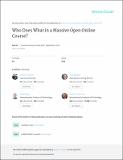| dc.contributor.author | Seaton, Daniel | |
| dc.contributor.author | Bergner, Yoav | |
| dc.contributor.author | Chuang, Isaac | |
| dc.contributor.author | Mitros, Piotr | |
| dc.contributor.author | Pritchard, David E | |
| dc.date.accessioned | 2017-07-21T15:37:51Z | |
| dc.date.available | 2017-07-21T15:37:51Z | |
| dc.date.issued | 2014-04 | |
| dc.identifier.issn | 0001-0782 | |
| dc.identifier.uri | http://hdl.handle.net/1721.1/110801 | |
| dc.description.abstract | Massive open online courses (MOOCs) collect valuable data onstudent learning behavior: essentially complete records of all student interactions in a self-contained learning environment,with the benefit of large sample sizes. We present an overview of how the 108,000 participants
behaved in 6.002x - Circuits and Electronics, the first course in MITx (now edX). We divide participants into tranches based on the extent of their assessment activities, ranging from browsers (who constituted ~
76% of the participants but accounted for only 8% of the total time
spent in the course) to certificate-earners (7% of theparticipants
who accounted for 60% of the total time). We examine how the certificate
earners allocated their time amongst the various course components and study what fraction of each they accessed. We analyze transitions
between course components, showing, how student behavior differs when solving homework vs. exam problems. This work lays the foundation for future studies of how use of various course components, and transitions
among them, influence learning in MOOCs. | en_US |
| dc.description.sponsorship | National Science Foundation (U.S.) (DUE-1044294) | en_US |
| dc.language.iso | en_US | |
| dc.publisher | Association for Computing Machinery (ACM) | en_US |
| dc.relation.isversionof | http://dx.doi.org/10.1145/2500876 | en_US |
| dc.rights | Creative Commons Attribution-Noncommercial-Share Alike | en_US |
| dc.rights.uri | http://creativecommons.org/licenses/by-nc-sa/4.0/ | en_US |
| dc.source | Other repository | en_US |
| dc.title | Who does what in a massive open online course? | en_US |
| dc.type | Article | en_US |
| dc.identifier.citation | Seaton, Daniel T.; Bergner, Yoav; Chuang, Isaac et al. “Who Does What in a Massive Open Online Course?” Communications of the ACM 57, 4 (April 2014): 58–65 | en_US |
| dc.contributor.department | Massachusetts Institute of Technology. Computer Science and Artificial Intelligence Laboratory | en_US |
| dc.contributor.department | Massachusetts Institute of Technology. Department of Electrical Engineering and Computer Science | en_US |
| dc.contributor.department | Massachusetts Institute of Technology. Department of Physics | en_US |
| dc.contributor.department | Massachusetts Institute of Technology. Office of Digital Learning | en_US |
| dc.contributor.department | Massachusetts Institute of Technology. Research Laboratory of Electronics | en_US |
| dc.contributor.mitauthor | Seaton, Daniel | |
| dc.contributor.mitauthor | Bergner, Yoav | |
| dc.contributor.mitauthor | Chuang, Isaac | |
| dc.contributor.mitauthor | Mitros, Piotr | |
| dc.contributor.mitauthor | Pritchard, David E | |
| dc.relation.journal | Communications of the ACM | en_US |
| dc.eprint.version | Original manuscript | en_US |
| dc.type.uri | http://purl.org/eprint/type/JournalArticle | en_US |
| eprint.status | http://purl.org/eprint/status/NonPeerReviewed | en_US |
| dspace.orderedauthors | Seaton, Daniel T.; Bergner, Yoav; Chuang, Isaac; Mitros, Piotr; Pritchard, David E. | en_US |
| dspace.embargo.terms | N | en_US |
| dc.identifier.orcid | https://orcid.org/0000-0001-7296-523X | |
| dc.identifier.orcid | https://orcid.org/0000-0001-5697-1496 | |
| mit.license | OPEN_ACCESS_POLICY | en_US |
| mit.metadata.status | Complete | |
